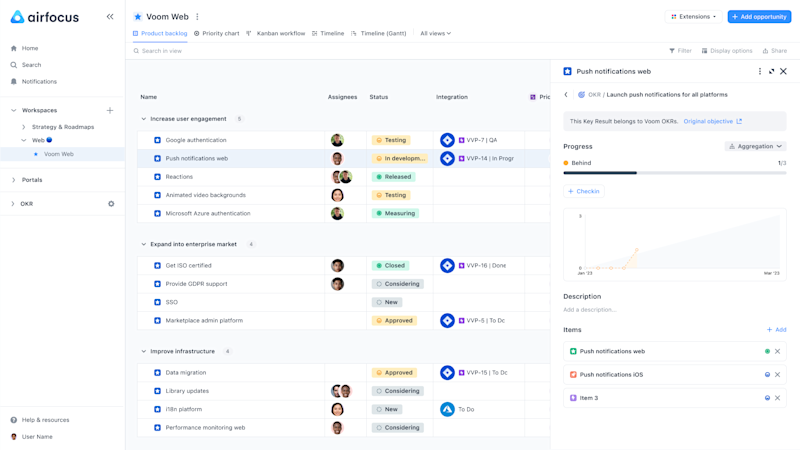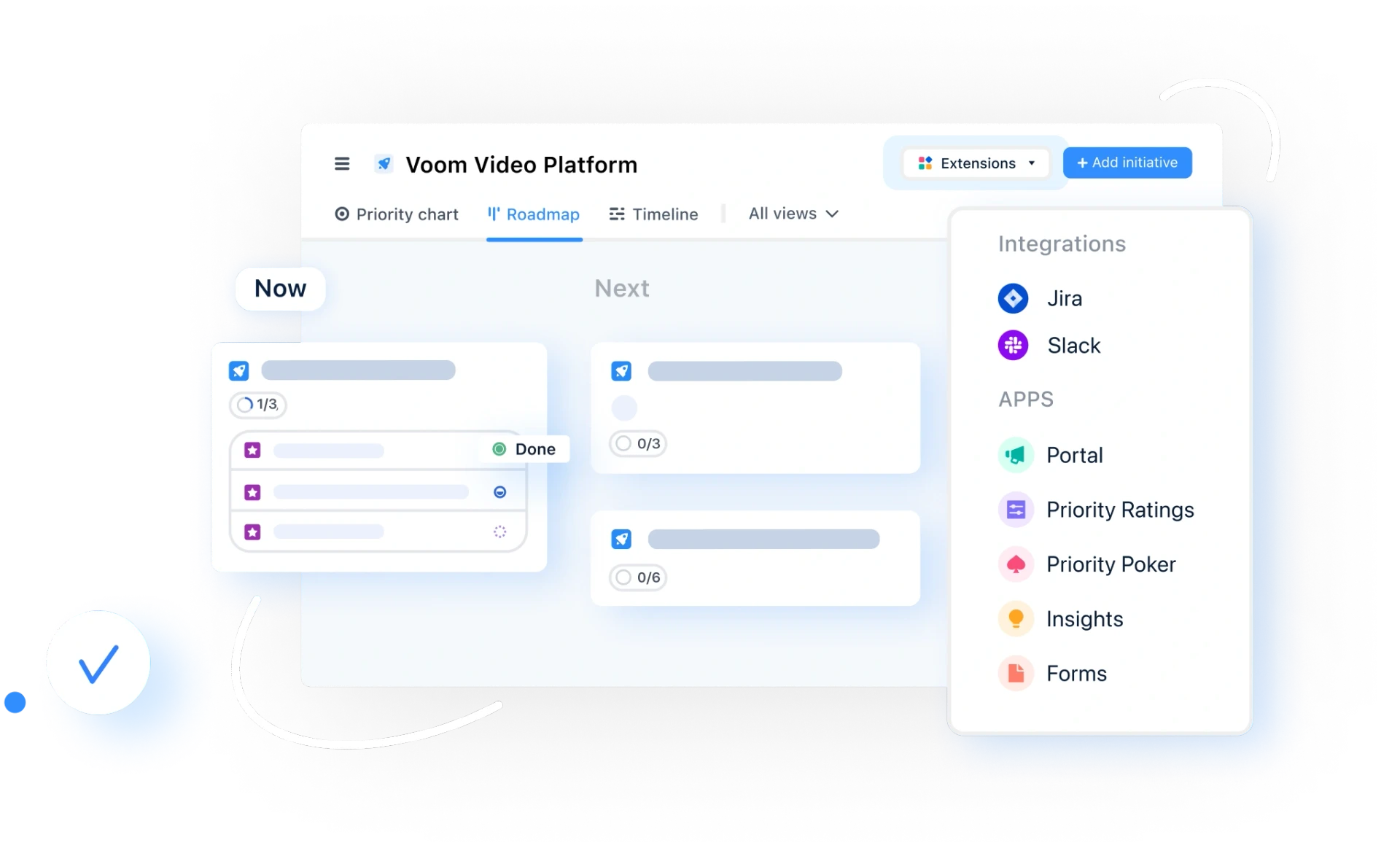User experience: 6 Key considerations when choosing product management tools

When evaluating product management software, it’s tempting to focus on features, integrations, or pricing. But the user experience (UX) can quietly make or break adoption. A clunky or confusing platform can isolate users, slow delivery, and force product managers back into spreadsheets and slide decks.
For Xina Trocco, Product Operations Director at Unanet, it was a key decision-making factor: when you’re spending every day on a platform, it’s integral to adoption and success. “The demo of airfocus was very successful with the product team,” she says. “airfocus was the most UX friendly, and it has the ability to be flexible – being able to adapt the tool based on our needs was highly important.”
But what does good UX really look like in a product management platform? To explore, we spoke with Daisy Dixon, Senior Account Executive at airfocus. Daisy works with product managers every day, helping them move away from fragmented tooling and toward scalable, outcome-driven product management.
Here are the six UX considerations she says every product manager should keep at the front of their mind.
1. Prioritize clarity over complexity
Product management tools can overload users with menus, buttons, and hidden options. That complexity can stop adoption before it starts. Daisy describes the UX landscape for product management tools as “very diverse,” with some platforms “highly flexible, but highly complex to use” and others “just not intuitive at all.”
She warns against products that overwhelm new users. “They’ve got all the bells and whistles, but the barrier to using them is ridiculous,” she says. “If a product doesn’t grab me in the first 20 minutes, I’m unlikely to go back to it.”
First impressions matter. If stakeholders can’t quickly understand what they’re looking at, the tool will fail to take root: “People make their mind up about a solution within the first five minutes of being in the tool. It’s like when you walk into an interview – people decide about you in the first 30 to 60 seconds. If it doesn’t feel intuitive straight away, adoption fails.”
This is why smooth onboarding, clear guidance, and a low barrier to entry are essential to getting teams engaged.
2. Look for flexibility without confusion
Flexibility is essential, but Daisy has seen how it often backfires. “Flexibility in a solution often means complexity. When you’re scaling across 10 product teams, that just compounds the problem.”
If the tool requires every team to configure their own workflows from scratch, consistency is lost and silos multiply. “It’s a delicate balance,” she says. “You need something adaptable, but not so customizable that it becomes a beast of a product.”
That’s why modular workspaces and ready-made templates in airfocus give teams the control they need while keeping set-up simple and consistent.

3. Collaboration across stakeholders
Product managers rarely work in isolation. They need to communicate with engineers, marketers, executives, and even boards. Without a usable tool, Daisy says, “product managers end up extracting the data, putting it into PowerPoint, and sharing that instead. But that’s the problem we’re trying to solve in the first place. If you don’t have a tool that fulfils that gap, you may as well just stick to Excel and PowerPoints.”
The right UX should make product data accessible to everyone, without endless repackaging: senior leaders need high-level strategy and outcomes, while engineers need to see tactical work. You can create different views based on your audience and goals, for example:
A table view for your backlog items.
A granular roadmap for your product or dev team.
A Now-Next-Later roadmap for leadership or cross-functional updates.
A Quarterly roadmap to support long-term planning.
4. Scalable permissions
As organisations grow, visibility itself becomes a UX challenge. “If you’re in a company like Google, you don’t want thousands of products cluttering your navigation,” Daisy explains. That’s where features like the new Member Groups feature in airfocus come in. “Member Groups make sure you only see what’s relevant – and that’s huge for usability and scalability.”
She points to features like advanced view permissions: “One of my largest enterprise customers said, ‘If we’re going to scale to a thousand contributors, we need a way to manage that volume easily.’ With advanced permissions, you’ll be able to invite colleagues to collaborate on specific views without exposing the entire workspace.” So while permissions are there for security reasons, they’re also about keeping the user experience clean and scalable.
5. Connecting strategy to execution
Many product managers tell Daisy their teams churn out features without being able to show whether they have an impact. “That’s why outcome-driven roadmaps are so important,” she explains.
She also highlights how airfocus helps manage opportunity backlogs: “Stakeholders come with amazing ideas, but you can’t do them all at once. You need somewhere to bank those opportunities and draw from them later. With the flexibility of airfocus, teams can organize requests and cherry-pick them six or twelve months later when the time is right.”
Strong UX means teams can connect day-to-day work directly back to company goals.

6. Fit within the wider tool stack
Finally, Daisy reminds product managers that UX isn’t just about the interface; it’s also about how well the tool fits into the broader ecosystem. “Your tool has to contribute positively to your ecosystem. Otherwise, you’re still operating in a silo. That’s why integrations with dev tools and comms tools are essential.”
She points to airfocus’ integration with Lucid: “Lucid is your what, and airfocus is your how. You brainstorm and ideate in Lucid, and once you’ve defined what you need to achieve, you push it into airfocus to structure the how. There’s no break in that process, which avoids misalignment.” And there’s more: The integration with delivery tools, such as Jira or Azure DevOps, allows you to seamlessly tie product initiatives to dev tasks.
A tool that integrates seamlessly strengthens collaboration across the organisation, and doesn��’t risk isolating the product team.
Often underestimated or seen as a secondary priority, user experience really should be the deciding factor in product management tool uptake.
“Ease of use shouldn’t be an afterthought – it should be at the top of every RFP,” Daisy says. She adds that teams who put usability first often see the greatest success: “The finance companies I work with put ease of use at the top of their list because their old tools were outdated spreadsheets. Transitioning into a better way of working meant usability had to be number one.”
So, when assessing potential tools, use these seven considerations as a framework. After all, UX ultimately determines whether a product management tool empowers or frustrates.
Emma-Lily Pendleton
Read also





Experience the new way of doing product management

Experience the new way of doing product management



